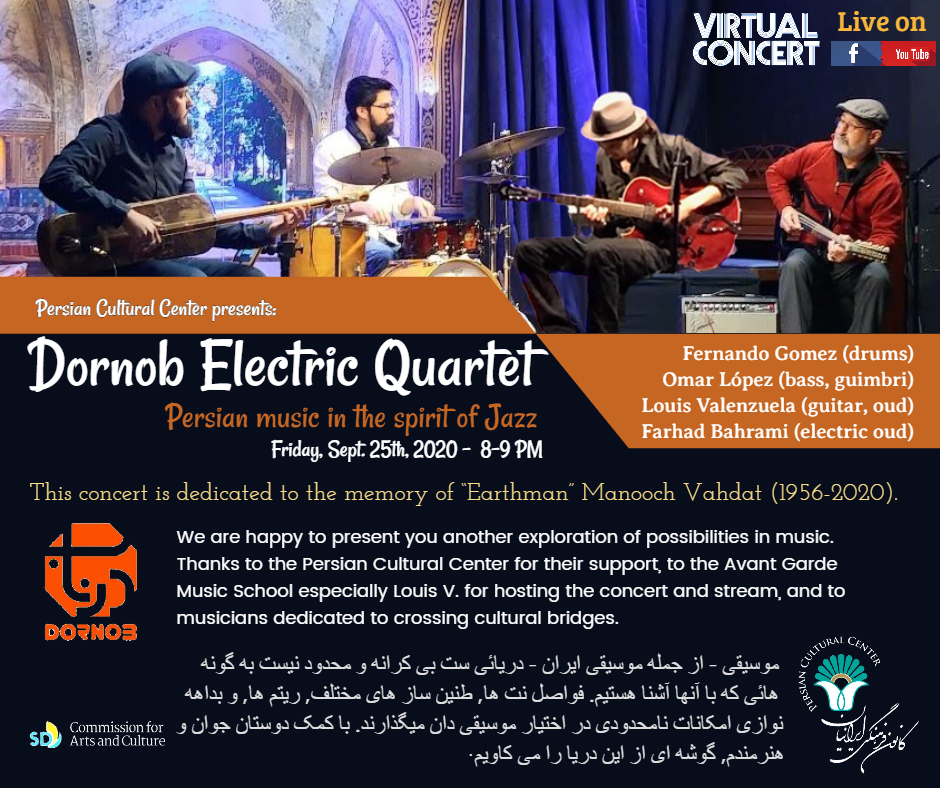
This event has passed.

Dornob Electric Quartet – Persian music in the spirit of Jazz
September 25, 2020 @ 8:00 pm - 9:00 pm UTC-8
Persian Cultural Center presents:
Dornob Electric Quartet
Persian music in the spirit of Jazz
Friday, Sept. 25th, 2020 – 8-9 PM
Live on Facebook (facebook.com/louis.valenzuela.58)
Live on YouTube (youtube.com/channel/UCqPeWmwaFBUTpd6S7HY8fQA)
Live on Facebook (facebook.com/louis.valenzuela.58)
Live on YouTube (youtube.com/channel/UCqPeWmwaFBUTpd6S7HY8fQA)
Donation: pccsd.eventbrite.com
Fernando Gomez (drums), Omar López (bass, guimbri), Louis Valenzuela (guitar, oud), Farhad Bahrami (electric oud)
We are happy to present to you another exploration of possibilities in music. Thanks to the Persian Cultural Center for their support, to the Avant-Garde Music School especially Louis V. for hosting the concert and stream, and to musicians dedicated to crossing cultural bridges.
موسیقی – از جمله موسیقی ایران – دریائی ست بی کرانه و محدود نیست به گونه هائی که با آنها آشنا هستیم. فواصل نت ها, طنین ساز های مختلف, ریتم ها, و بداهه نوازی امکانات نامحدودی در اختیار موسیقی دان میگذارند. با کمک دوستان جوان و هنرمندم, گوشه ای از این دریا را می کاویم
This concert is dedicated to the memory of “Earthman” Manooch Vahdat (1956-2020).
We are happy to present to you another exploration of possibilities in music. Thanks to the Persian Cultural Center for their support, to the Avant-Garde Music School especially Louis V. for hosting the concert and stream, and to musicians dedicated to crossing cultural bridges.
موسیقی – از جمله موسیقی ایران – دریائی ست بی کرانه و محدود نیست به گونه هائی که با آنها آشنا هستیم. فواصل نت ها, طنین ساز های مختلف, ریتم ها, و بداهه نوازی امکانات نامحدودی در اختیار موسیقی دان میگذارند. با کمک دوستان جوان و هنرمندم, گوشه ای از این دریا را می کاویم
This concert is dedicated to the memory of “Earthman” Manooch Vahdat (1956-2020).
Program
- Borders چهار حصار Chahargah.
- Nina Dedicated to one gone too soon. Homayun.
- All Shur Tanburi Cemil Bey (1873-1916). Adapted.
- Vayemo Traditional from Khorasan. Shur.
- Vote! It’s Your Right Traditional from Khuzestan. Adapted. Shur.
- Coltrane in Bahrain
- Omar
- Dirge for M سوگ
- Free at Last
- Mr. Jesse John Coltrane (1926-1967). Adapted to Shur.
- Ilhan
Composed by F. Bahrami unless otherwise noted.
The Music
The “Middle East” is a fairly recent name for a vast geographical region with a long shared history, stretching from perhaps Afghanistan in the East, across the Mediterranean, and North Africa, almost to Spain in the West. It’s history – and hence it’s music – is defined by the three big empires: Persian, Arabian, and Ottoman, each dominating a huge area for hundreds of years.
Even so, many many other nations, notably the Kurds, Armenians, Greeks, Chaldeans, Assyrians, and others contributed to the rich culture and music of the Middle East (ME). So, maybe it’s more accurate to speak of the many musics of the ME, rather than Middle Eastern music.
Some general characteristics of Middle Eastern musics include the use of so-called “quarter tones” (absent from the piano and guitar), ample improvisation, and a traditional way of teaching heart-to-heart. Additionally, Middle Eastern musics share a tonal concept called maqâm, somewhat similar to Western scales. Persian music additionally uses a system called dastgâh, which provides a framework for navigating between maqâms.
Jazz is an African-American art form from the 20th century. The development of jazz includes roots in the folk musics of the South with influences from Latin and European musics, through mainstream acceptance as a dance music prior to World War II, to a more abstract improvisational form of expression in the last half-century.
Grossmont College world music instructor Farhad Bahrami – with help from veterans of the San Diego jazz and Latin scene: Omar López, Fernando Gomez, and Louis Valenzuela – re-imagines Persian classical and folk melodies within the group framework of jazz, as an example of the possibilities inherent in world musics.
The “Middle East” is a fairly recent name for a vast geographical region with a long shared history, stretching from perhaps Afghanistan in the East, across the Mediterranean, and North Africa, almost to Spain in the West. It’s history – and hence it’s music – is defined by the three big empires: Persian, Arabian, and Ottoman, each dominating a huge area for hundreds of years.
Even so, many many other nations, notably the Kurds, Armenians, Greeks, Chaldeans, Assyrians, and others contributed to the rich culture and music of the Middle East (ME). So, maybe it’s more accurate to speak of the many musics of the ME, rather than Middle Eastern music.
Some general characteristics of Middle Eastern musics include the use of so-called “quarter tones” (absent from the piano and guitar), ample improvisation, and a traditional way of teaching heart-to-heart. Additionally, Middle Eastern musics share a tonal concept called maqâm, somewhat similar to Western scales. Persian music additionally uses a system called dastgâh, which provides a framework for navigating between maqâms.
Jazz is an African-American art form from the 20th century. The development of jazz includes roots in the folk musics of the South with influences from Latin and European musics, through mainstream acceptance as a dance music prior to World War II, to a more abstract improvisational form of expression in the last half-century.
Grossmont College world music instructor Farhad Bahrami – with help from veterans of the San Diego jazz and Latin scene: Omar López, Fernando Gomez, and Louis Valenzuela – re-imagines Persian classical and folk melodies within the group framework of jazz, as an example of the possibilities inherent in world musics.
